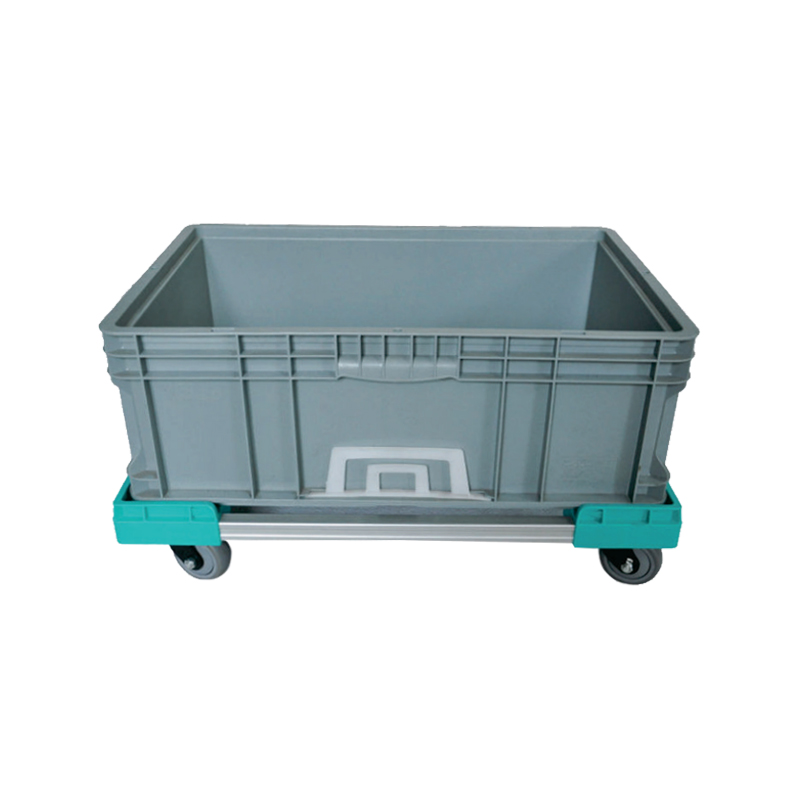When using plastic pallet dollies to move large goods, several safety issues should be considered to prevent accidents, injuries, and damage to the goods. Here are key safety considerations:
Weight Capacity Limits:Adhere to Weight Limits: Ensure that the load on the dolly does not exceed its maximum weight capacity, as overloading can lead to structural failure, tipping, or damage to the dolly.Even Load Distribution: Distribute the load evenly across the surface of the dolly to avoid instability or tipping while moving.
Stability and Load Security:Secure the Load: Large or irregularly shaped goods should be properly secured with straps or shrink wrap to prevent shifting or falling during movement.Avoid Overhanging Loads: Ensure that the goods do not overhang excessively, which can make the dolly unstable and increase the risk of tipping.Low Center of Gravity: Keep the load's center of gravity as low as possible to improve stability, especially when moving taller or heavy items.
Terrain and Surface Considerations:Check the Surface Condition: Ensure that the surface over which the dolly will be moved is smooth, level, and free of debris. Uneven surfaces or obstructions can cause the dolly to tip or the wheels to become stuck.Wheel Compatibility: Use a dolly with appropriate wheels for the surface (e.g., larger, rubberized wheels for rough terrain or smaller, smooth wheels for indoor use).Avoid Slippery Surfaces: Be cautious when moving dollies on wet, oily, or slippery surfaces, as the dolly could slide out of control.

Handling and Maneuverability:Push, Don’t Pull: Push the dolly rather than pulling it. Pushing allows better control and reduces the risk of straining muscles or losing balance.Use Proper Body Mechanics: Use proper lifting techniques when placing goods on the dolly to avoid back strain. Bend your knees, lift with your legs, and avoid twisting your back.Maneuver Slowly: Move the dolly at a controlled speed, especially around corners or through tight spaces, to avoid collisions or losing control of the load.
Braking and Stopping Mechanisms:Check for Brakes: Some dollies are equipped with brakes to prevent unwanted movement, especially on sloped surfaces. Always engage the brake when loading or unloading heavy goods.Stop Gradually: Avoid making sudden stops, as this could cause the load to shift or fall.
Visibility and Clearance:Maintain Clear Visibility: Ensure that the load on the dolly does not obstruct the operator’s line of sight. If the load is too large, use a spotter to guide the movement.Check for Adequate Clearance: Ensure that there is enough space to maneuver the dolly without hitting walls, doorways, or other objects that could cause the load to fall.
Use on Inclines and Declines:Avoid Slopes: Avoid moving heavy loads on steep inclines or declines. If necessary, use additional help or mechanical assistance to control the dolly on slopes.Use Proper Wheel Blocks or Brakes: When stopping on an incline, use wheel chocks or engage the brakes to prevent the dolly from rolling away.
Multiple Operators and Assistance:Team Lifting: For particularly heavy or bulky loads, use multiple operators to push the dolly. Ensure good communication and coordination between all handlers.Seek Help with Large Loads: If the load is too large or awkward to move safely by yourself, enlist help from other workers.
Inspect the Dolly for Damage:Regular Inspections: Regularly check the plastic pallet dolly for signs of wear, cracks, or damage, particularly to the frame and wheels. A damaged dolly can fail under load, leading to accidents.Check Wheels and Bearings: Inspect the wheels and bearings to ensure they are in good working order, with no debris, cracks, or excessive wear.
Use of Personal Protective Equipment (PPE):Wear Appropriate Footwear: Use non-slip, sturdy shoes to ensure stability and protection while operating the dolly.Gloves for Handling: If handling heavy or rough materials, wear gloves to protect your hands from cuts or abrasions.
Follow Proper Loading and Unloading Procedures:Stable Surface for Loading: Ensure the dolly is on a stable and flat surface before loading and unloading to prevent tipping.Secure While Loading: Engage the brakes or hold the dolly steady while loading to avoid any unexpected movement.
By considering these safety precautions, you can minimize risks and safely use plastic pallet dollies to move large goods in various work environments.
